95 have author last names that start with S have author last names that start with S
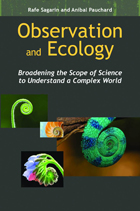
The need to understand and address large-scale environmental problems that are difficult to study in controlled environments—issues ranging from climate change to overfishing to invasive species—is driving the field of ecology in new and important directions. Observation and Ecology documents that transformation, exploring how scientists and researchers are expanding their methodological toolbox to incorporate an array of new and reexamined observational approaches—from traditional ecological knowledge to animal-borne sensors to genomic and remote-sensing technologies—to track, study, and understand current environmental problems and their implications.
The authors paint a clear picture of what observational approaches to ecology are and where they fit in the context of ecological science. They consider the full range of observational abilities we have available to us and explore the challenges and practical difficulties of using a primarily observational approach to achieve scientific understanding. They also show how observations can be a bridge from ecological science to education, environmental policy, and resource management.
Observations in ecology can play a key role in understanding our changing planet and the consequences of human activities on ecological processes. This book will serve as an important resource for future scientists and conservation leaders who are seeking a more holistic and applicable approach to ecological science.
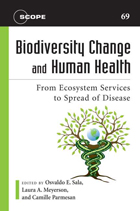
health trade-offs between competing uses of biodiversity (highlighting synergistic situations in which conservation of natural biodiversity actually promotes human health and well-being);
relationships between biodiversity and quality of life that have developed over ecological and evolutionary time;
the effects of changing biodiversity on provisioning of ecosystem services, and how they have affected human health; the role of biodiversity in the spread of infectious disease;
native biodiversity as a resource for traditional and modern medicine
Biodiversity Change and Human Health synthesizes our current understanding and identifies major gaps in knowledge as it places all aspects of biodiversity and health interactions within a common framework. Contributors explore potential points of crossover among disciplines (both in ways of thinking and of specific methodologies) that could ultimately expand opportunities for humans to both live sustainably and enjoy a desirable quality of life.
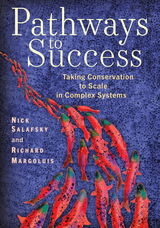
In this strikingly illustrated volume, coauthors Nick Salafsky and Richard Margoluis walk readers through fundamental concepts of effective program-level design, helping them to think strategically about project coordination, funding, and stakeholder input. Chapters in the first part of the book look at all aspects of designing and implementing large-scale conservation programs while the second part focuses on how to use data and information to manage, adapt, and learn from program strategies. In addition, the authors offer practical advice for avoiding pitfalls, such as formulaic recipes and simplistic silver-bullet solutions that can trip up otherwise well-intentioned efforts. Abundant graphics help to explain and clarify concepts presented in the text, and a glossary in the back matter defines technical terms for the reader.
Pathways to Success is the definitive guide for conservation program managers and funders who want to increase the scale and effectiveness of their work combating biodiversity loss, climate change, and other pressing environmental issues.
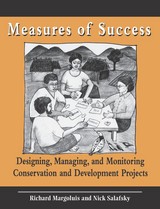
Measures of Success is a practical, hands-on guide to designing, managing, and measuring the impacts of community-oriented conservation and development projects. It presents a simple, clear, logical, and yet comprehensive approach to developing and implementing effective programs, and can help conservation and development practitioners use principles of adaptive management to test assumptions about their projects and learn from the results.
The book presents a systematic approach to improving the focus, effectiveness, and efficiency of projects, with specific guidelines and advice on:
- designing a realistic conceptual framework based on local site conditions
- developing clearly defined goals, objectives, and activities
- creating a monitoring plan that can be used to assess whether goals and objectives are being met
- integrating social and biological science techniques to collect the most relevant and useful data in the most cost-effective way
- using the information obtained through the monitoring plan to modify the project and learn from the result
The text is developed in eight chapters that follow the structure of a planning process from conception to completion, with the chapters linked by four scenarios that serve as teaching case studies throughout the book. Examples from these scenarios illustrate the processes and tools discussed, and each scenario case study is presented in its entirety in an appendix to the volume. The approach has been developed and field tested by practitioners working in many different projects in Latin America, Africa, and Asia, and their experience and input ensure that the guide is both practical and useful.
Measures of Success is the only work of its kind currently available, and represents an invaluable resource for field-based practitioners, project managers, and local community leaders, as well as for international NGO staff, college and university teachers and students, researchers, and government officials.
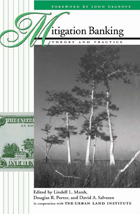
Under the Clean Water Act, development that results in the permanent destruction of wetlands must, in most cases, be mitigated by the creation of a new wetland or the restoration of a degraded one. In recent years, the concept of "mitigation banking" has emerged. Rather than require developers to create and maintain wetlands on their own on a quid pro quo basis, mitigation banking allows them to pay for wetlands that have been created and maintained properly by others to compensate for their damage.
The contributors to this volume provide an overview of mitigation banking experience in the United States, examine the key issues and concerns -- from providing assurances to determining the value of credits -- and describe the practice of developing and operating a mitigation bank. Topics include:
- history and current experience of mitigation banking
- policies and concerns of local, state, and federal agencies
- economics of mitigation banking
- funding, management, and operation of banks
- starting a mitigation bank
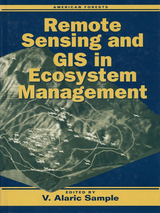
Recent advances in remote-sensing technology and the processing of remote-sensing data through geographic information systems (GIS) present ecologists and resource managers with a tremendously valuable tool -- but only if they are able to understand its capabilities and capture its potential.
Remote Sensing and GIS in Ecosystem Management identifies and articulates current and emerging information needs of those involved with the management of forest ecosystems. It explores the potential of remote-sensing/GIS technologies to address those needs, examining:
- the need for landscape-scale analysis to support forest ecosystem research and management
- current challenges in the development of remote-sensing/GIS applications
- case studies of different forest regions in the United States
- the potential for further development or declassification of military and aerospace remote-sensing/GIS technologies
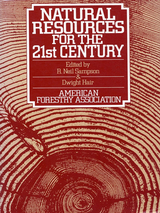
Natural Resources for the 21st Century is an in-depth assessment by natural resource experts that offers a reliable status report on water, croplands, soil, forests, wetlands, rangelands, fisheries, wildlife, and wilderness.

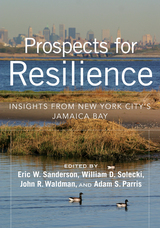
Prospects for Resilience establishes a framework for understanding resilience practice in urban watersheds. Using Jamaica Bay—the largest contiguous natural area in New York, home to millions of New Yorkers, and a hub of global air travel with John F. Kennedy International Airport—the authors demonstrate how various components of social-ecological systems interact, ranging from climatic factors to plant populations to human demographics. They also highlight essential tools for creating resilient watersheds, including monitoring and identifying system indicators; computer modeling; green infrastructure; and decision science methods. Finally, they look at the role and importance of a “boundary organization” like the new Science and Resilience Institute at Jamaica Bay in coordinating and facilitating resilience work, and consider significant research questions and prospects for the future of urban watersheds.
Prospects for Resilience sets forth an essential foundation of information and advice for researchers, urban planners, students and others who need to create more resilient cities that work with, not against, nature.
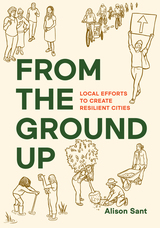
The efforts discussed in the book demonstrate how urban experimentation and community-based development are informing long-term solutions. Sant shows how US cities are reclaiming their streets from cars, restoring watersheds, growing forests, and adapting shorelines to improve people’s lives while addressing our changing climate. The best examples of this work bring together the energy of community activists, the organization of advocacy groups, the power of city government, and the reach of federal environmental policy.
Sant presents 12 case studies, drawn from research and over 90 interviews with people who are working in these communities to make a difference. For example, advocacy groups in Washington, DC are expanding the urban tree canopy and offering job training in the growing sector of urban forestry. In New York, transit agencies are working to make streets safer for cyclists and pedestrians while shortening commutes. In San Francisco, community activists are creating shoreline parks while addressing historic environmental injustice.
From the Ground Up is a call to action. When we make the places we live more climate resilient, we need to acknowledge and address the history of social and racial injustice. Advocates, non-profit organizations, community-based groups, and government officials will find examples of how to build alliances to support and embolden this vision together. Together we can build cities that will be resilient to the challenges ahead.
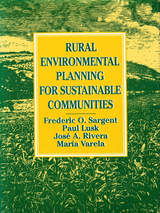
Rural Environmental Planning for Sustainable Communities offers an explanation of the concept of Rural Environmental Planning (REP) along with case studies that show how to apply REP to specific issues such as preserving agricultural lands, planning river and lake basins, and preserving historical sites.
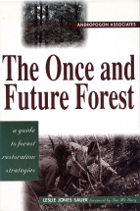
Developed by the pioneering landscape design firm of Andropogon Associates, world-renowned for their innovative approach to integrating environmental protection and restoration with landscape architecture and design, The Once and Future Forest is a guidebook for restoring and managing natural landscapes. Focusing on remnant forest systems, it describes methods of restoring and linking forest fragments to recreate a whole landscape fabric.
The book begins by explaining the history and current situation of forest ecosystems in the eastern United States. Following that is an in-depth examination of the restoration process, with thorough descriptions of ecological strategies for landscape management along with specific examples of how those strategies have been implemented in various sites around the country. The final section provides hands-on information about the many specific details that must be considered when initiating and implementing a restoration program. All aspects of the restoration process are considered, including: Water -- opportunities for increasing infiltration, reducing pollutants, promoting habitat values Ground -- methods of protecting existing vegetation, removing fill, rebuilding soils Plants -- strategies and procedures for planting, maintenance, propagation Wildlife -- guidelines for preserving wildlife resources, management techniques to favor selected specie.
The Once and Future Forest presents a comprehensive approach to assessing sites, detailed guidelines for determining management goals, and a thorough overview of appropriate management and restoration techniques. It is an important guide for professional planners and landscape architects, government agency personnel at all levels, land managers, scientists involved in restoration work, and citizen activists who wish to do something constructive about our deteriorating forest patches.
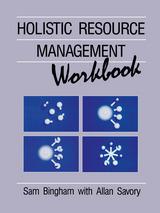
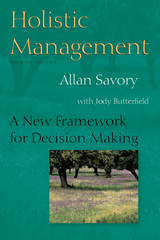
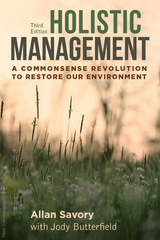
Holistic management is a systems-thinking approach for managing resources developed by Savory decades ago after observing the devastation of desertification in his native Southern Rhodesia (now Zimbabwe). Properly managed livestock are key to restoring the world’s grassland soils, the major sink for atmospheric carbon, and minimizing the most damaging impacts on humans and the natural world. This book updates Savory's paradigm-changing vision for reversing desertification, stemming the loss of biodiversity, eliminating fundamental causes of human impoverishment throughout the world, and climate change. Reorganized chapters make it easier for readers to understand the framework for Holistic Management and the four key insights that underlie it. New color photographs showcase before-and-after examples of land restored by livestock.
This long-anticipated new edition is written for new generations of ranchers, farmers, eco- and social entrepreneurs, and development professionals working to address global environmental and social degradation. It offers new hope that a sustainable future for humankind and the world we depend on is within reach.

That experience, along with the guidance of leaders in systems thinking and racial justice, convinced her that the world’s thorniest problems may be easier to tackle together than one by one. That’s multisolving: using a single investment of time or money to solve many problems at the same time. (Reduced fossil fuel use = improvements in climate, health, equity, economics, and more.) While the idea of killing two birds with one stone (or “filling two needs with one deed”) is age-old, and the notion of co-benefits in policy-making has been around for years, Multisolving addresses the current mismatch between complex, deeply intertwined societal issues and our siloed approach to them.
This unique resource is for local school boards that need revenue for their students but don’t want to overtax low-income seniors. It is for nonprofits working to reduce food waste and combat the root causes of hunger while increasing racial justice. It is for seaside communities that can protect themselves from flooding while also improving biodiversity with a living coastline. It may also be for you: doing the work you know is imperative but that is sometimes overwhelming, a tiny a drop in a swirling ocean.
Multisolving can’t promise a list of “fifty simple things to make everything OK.” What it does offer are strategies to build solidarity between diverse groups, overcome powerful interests, and create last change that benefits us all.
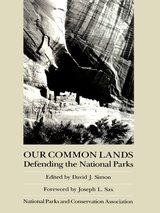
This accessible book explains the complexities of key environmental laws and how they can be used to protect our national parks. It includes discussions of successful and unsuccessful attempts to use the laws and how the courts have interpreted them.

Tibet Wild is Schaller’s account of three decades of exploration in the most remote stretches of Tibet: the wide, sweeping rangelands of the Chang Tang and the hidden canyons and plunging ravines of the southeastern forests. As engaging as he is enlightening, Schaller illustrates the daily struggles of a field biologist trying to traverse the impenetrable Chang Tang, discover the calving grounds of the chiru or Tibetan antelope, and understand the movements of the enigmatic snow leopard.
As changes in the region accelerated over the years, with more roads, homes, and grazing livestock, Schaller watched the clash between wildlife and people become more common—and more destructive. Thus what began as a purely scientific endeavor became a mission: to work with local communities, regional leaders, and national governments to protect the unique ecological richness and culture of the Tibetan Plateau.
Whether tracking brown bears, penning fables about the tiny pika, or promoting a conservation preserve that spans the borders of four nations, Schaller has pursued his goal with a persistence and good humor that will inform and charm readers. Tibet Wild is an intimate journey through the changing wilderness of Tibet, guided by the careful gaze and unwavering passion of a life-long naturalist.
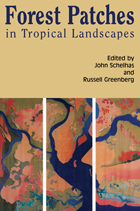
This volume brings together world-renowned scientists and conservationists to address the biological and socio-economic value of forest remnants and to examine practical efforts to conserve those remnants. An outgrowth of a year-long study by the policy program at the Smithsonian Migratory Bird Center, Forest Patches in Tropical Landscapes provides a broad overview of theory and practice, and will help foster both interdisciplinary research and more effective approaches to tropical conservation and development.
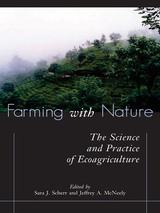
Farming with Nature offers a synthesis of the state of knowledge of key topics in ecoagriculture. The book is a unique collaboration among renowned agricultural and ecological scientists, leading field conservationists, and farm and community leaders to synthesize knowledge and experience across sectors. The book examines:
- the knowledge base for ecoagriculture as well as barriers, gaps, and opportunities for developing improved ecoagriculture systems
- what we have learned about managing landscapes to achieve multiple objectives at a landscape scale
- existing incentives for farmers, other land managers, and investors to develop and invest in ecoagriculture systems
- pathways to develop, implement, manage, and scale up successful ecoagriculture
the field.

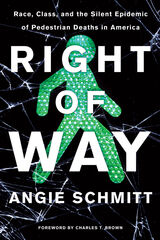
The tragedy of traffic violence has barely registered with the media and wider culture. Disproportionately the victims are like Duarte-Rodriguez—immigrants, the poor, and people of color. They have largely been blamed and forgotten.
In Right of Way, journalist Angie Schmitt shows us that deaths like Duarte-Rodriguez’s are not unavoidable “accidents.” They don’t happen because of jaywalking or distracted walking. They are predictable, occurring in stark geographic patterns that tell a story about systemic inequality. These deaths are the forgotten faces of an increasingly urgent public-health crisis that we have the tools, but not the will, to solve.
Schmitt examines the possible causes of the increase in pedestrian deaths as well as programs and movements that are beginning to respond to the epidemic. Her investigation unveils why pedestrians are dying—and she demands action. Right of Way is a call to reframe the problem, acknowledge the role of racism and classism in the public response to these deaths, and energize advocacy around road safety. Ultimately, Schmitt argues that we need improvements in infrastructure and changes to policy to save lives.
Right of Way unveils a crisis that is rooted in both inequality and the undeterred reign of the automobile in our cities. It challenges us to imagine and demand safer and more equitable cities, where no one is expendable.

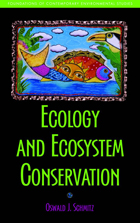
The book begins by exploring the need for ecological science in understanding current environmental issues and briefly discussing what ecology is and isn’t. Subsequent chapters address critical issues in conservation and show how ecological science can be applied to them. The book explores questions such as:
• What is the role of ecological science in decision making?
• What factors govern the assembly of ecosystems and determine their response to various stressors?
• How does Earth’s climate system function and determine the distribution of life on Earth?
• What factors control the size of populations?
• How does fragmentation of the landscape affect the persistence of species on the landscape?
• How does biological diversity influence ecosystem processes?
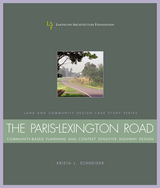
Located in the heart of the Kentucky Bluegrass Region, the "Paris Pike" is a scenic, twelve-mile corridor running between Lexington and Paris. Beginning in 1969, the state of Kentucky sought to widen the road in order to improve safety and capacity. Various objections led to a federal court injunction imposed in 1979 that halted the project for more than fifteen years. Over the span of three decades, several consultant studies contributed to the public understanding of the road's significance and set the stage for what has been regarded as the model for context-sensitive road reconstruction in America.
The Paris-Lexington Road focuses on the history of the reconstruction of the Paris Pike (now renamed the "Paris-Lexington Road") to critically review this reconstruction project and illustrate its significance to the profession of landscape architecture. It also situates the role of landscape architects in the history of highway design, and examines the various contemporary challenges and opportunities represented within the Paris Pike project.
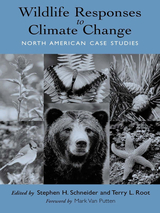
Wildlife Responses to Climate Change is the culmination of a three-year project to research and study the impacts of global climate change on ecosystems and individual wildlife species in North America. In 1997, the National Wildlife Federation provided fellowships to eight outstanding graduate students to conduct research on global climate change, and engaged leading climate change experts Stephen H. Schneider and Terry L. Root to advise and guide the project. This book presents the results, with chapters describing groundbreaking original research by some of the brightest young scientists in America. The book presents case studies that examine:
- ways in which local and regional climate variables affect butterfly populations and habitat ranges
- how variations in ocean temperatures have affected intertidal marine species
- the potential effect of reduced snow cover on plants in the Rocky Mountains
- the potential effects of climate change on the distribution of vegetation in the United States
- how climate change may increase the susceptibility of ecosystems to invasions of non-native species
- the potential for environmental change to alter interactions between a variety of organisms in whitebark pine communities of the Greater Yellowstone Ecosystem
Each of the eight case studies provides important information about how biotic systems respond to climatic variables, and how a changing climate may affect biotic systems in the future. They also acknowledge the inherent complexities of problems likely to arise from changes in climate, and demonstrate the types of scientific questions that need to be explored in order to improve our understanding of how climate change and other human disturbances affect wildlife and ecosystems.
Wildlife Responses to Climate Change is an important addition to the body of knowledge critical to scientists, resource managers, and policymakers in understanding and shaping solutions to problems caused by climate change. It provides a useful resource for students and scientists studying the effects of climate change on wildlife and will assist resource managers and other wildlife professionals to better understand factors affecting the species they are striving to conserve.
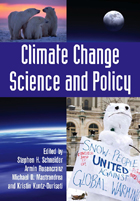
In many ways, this volume supersedes the Fourth Assessment Report of the Intergovernmental Panel on Climate Change (IPCC). Many important developments too recent to be treated by the 2007 IPCC documents are covered here. This book considers not only the IPCC report, but also results of the UN Framework Convention on Climate Change held in Bali in December 2007, as well as even more recent research data. Overall, Climate Change Science and Policy paints a direr picture of the effects of climate change than do the IPCC reports. It reveals that climate change has progressed faster than the IPCC reports anticipated and that the outlook for the future is bleaker than the IPCC reported.
In his prologue, John P. Holdren writes that the widely-used term “ global warming” is a misnomer. He suggests that a more accurate label would be “ global climatic disruption.” This volume, he states, will equip readers with all they need to know to rebut the misrepresentations being propagated by “ climate-change skeptics.” No one, he writes, will be a skeptic after reading this book.
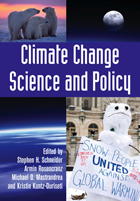
Questions surrounding the issue of climate change are evolving from "Is it happening?" to "What can be done about it?" The primary obstacles to addressing it at this point are not scientific but political and economic; nonetheless a quick resolution is unlikely.
Ignorance and confusion surrounding the issue -- including a lack of understanding of climate science, its implications for the environment and society, and the range of policy options available -- contributes to the political morass over dealing with climate change in which we find ourselves. Climate Change Policy addresses that situation by bringing together a wide range of new writings from leading experts that examine the many dimensions of the topics most important in understanding climate change and policies to combat it. Chapters consider:
- climate science in historical perspective
- analysis of uncertainties in climate science and policy
- the economics of climate policy
- North-South and intergenerational equity issues
- the role of business and industry in climate solutions
- policy mechanisms including joint implementation, emissions trading, and the so-called clean development mechanism
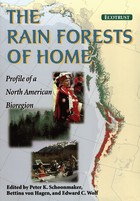
Stretching from the redwoods of California to the vast stands of spruce and hemlock in southeast Alaska, coastal temperate rain forests have been for thousands of years home to one of the highest densities of human settlements on the continent. Given its mild climate, magnificent scenery, and abundant natural resources, the region should continue to support robust economies and vibrant communities for many years to come. However, the well-being of this region is increasingly threatened by diminishing natural capital, declining employment in traditional resource-based industries, and outward migration of young people to cities.
The Rain Forests of Home brings together a diverse array of thinkers -- conservationists, community organizers, botanists, anthropologists, zoologists, Native Americans, ecologists, and others -- to present a multilayered, multidimensional portrait of the coastal temperate rain forest and its people. Joining natural and social science perspectives, the book provides readers with a valuable understanding of the region's natural and human history, along with a vision of its future and strategies for realizing that vision.
Authors describe the physical setting and examine the geographic and evolutionary forces that have shaped the region since the last glacial period, with individual chapters covering oceanography, climate, geologic processes, vegetation, fauna, streams and rivers, and terrestrial/marine interactions. Three chapters cover the history of human habitation, including an examination of what is known about pre-European settlement, a consideration of the traditions of local and indigenous knowledge, and a description of the environmental and cultural upheaval brought by European explorers and settlers. The book concludes with an exploration of recent economic and cultural trends, regional and local public policy, information gathering, and the need for integrating local knowledge into decision making.
Interspersed among the chapters are compelling profiles of community-level initiatives and programs aimed at restoring damaged ecosystems, promoting sustainable use of resources, and fostering community-based economic development. The case studies describe what coastal residents are doing to combine environmental conservation with socioeconomic development, and document some of the most innovative experiments in sustainable development now underway in North America.
The Rain Forests of Home offers for the first time a unified description of the characteristics, history, culture, economy, and ecology of the coastal temperate rain forest. It is essential reading for anyone who lives in or cares about the region.
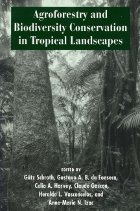
Agroforestry -- the practice of integrating trees and other large woody perennials on farms and throughout the agricultural landscape -- is increasingly recognized as a useful and promising strategy that diversifies production for greater social, economic, and environmental benefits. Agroforestry and BiodiversityConservation in Tropical Landscapes brings together 46 scientists and practitioners from 13 countries with decades of field experience in tropical regions to explore how agroforestry practices can help promote biodiversity conservation in human-dominated landscapes, to synthesize the current state of knowledge in the field, and to identify areas where further research is needed.
Agroforestry and Biodiversity Conservation in Tropical Landscapes is the first comprehensive synthesis of the role of agroforestry systems in conserving biodiversity in tropical landscapes, and contains in-depth review chapters of most agroforestry systems, with examples from many different countries. It is a valuable source of information for scientists, researchers, professors, and students in the fields of conservation biology, resource management, tropical ecology, rural development, agroforestry, and agroecology.

Schwartzstein has visited ravaged Iraqi towns where ISIS used drought as a recruiting tool and weapon of terror. In Bangladesh, he has interviewed farmers-turned-pirates who can no longer make a living off the land and instead make it off bloody ransoms. Security forces have blocked him from a dam being constructed along the Nile that has brought Egypt and Ethiopia to the brink of war. And he has heard the fear in the voices of women from around the world who say their husbands’ tempers flare when the temperature ticks up.
In The Heat and the Fury, he not only puts readers on the frontlines of climate violence but gives us the context to make sense of seemingly senseless acts. As Schwartzstein deftly shows, climate change is often the spark that ignites long smoldering fires, the extra shove that pushes individuals, communities, and even nations over the line between frustration and lethal fury. What, he asks, can ratchet down the aggression? Can cooperation on climate actually become a salve to heal old wounds?
There are no easy answers on a planet that is fast becoming a powder keg. But Schwartzstein’s incisive analysis of geopolitics, unparalleled on-the-ground reporting, and keen sense of human nature offer the clearest picture to date of the violence that threatens us all.
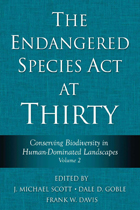
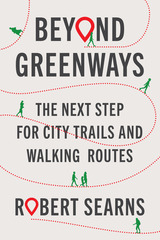
In Beyond Greenways: The Next Step for City Trails and Walking Routes, greenways expert Robert Searns makes a case for walking infrastructure that serves a more diverse array of people. He builds on the legacy of boulevards, parkways, and greenways to introduce a next generation of more accessible pathways, wide enough for two people to stroll together, that stitch together urban and suburban areas. With more trails built near neighborhoods that haven’t had access to them, more people can get around on foot, in town or further out. Searns lays out practical advice on how to plan and design them, garner community support, and get them built. Drawing inspiration from the US and abroad, he introduces two models—grand loop trails and town walks. Grand loop trails are regional-scale, 20 to 350-mile systems that encircle metro areas, running along the edges where city meets countryside. Town walks are shorter—2 to 6-mile routes in cities. Throughout, Searns presents examples that embody these ideals, from Tucson’s Turquoise Trail, created by just two people with an idea and some left-over blue paint the city had, to a more deluxe 5-mile loop in Denver, to the Maricopa trail in Phoenix, a completed 315 mile grand loop. He also envisions these trails in new places across North America.
Planners, trail advocates, community leaders and those who just want closer-in places to hike or walk will find the tools they need to develop successful and affordable plans, including how to envision them to fit various settings and strategies for implementation. Now is the time to think beyond greenways, to pursue a legacy of accessible pedestrian routes for this, and future, generations.
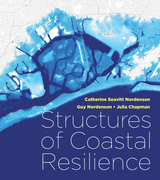
Authors Catherine Seavitt Nordenson, Guy Nordenson, and Julia Chapman have been at the forefront of research on new approaches to effective coastal resilience planning for over a decade. In Structures of Coastal Resilience, they reimagine how coastal planning might better serve communities grappling with a future of uncertain environmental change. They encourage more creative design techniques at the beginning of the planning process, and offer examples of innovative work incorporating flexible natural systems into traditional infrastructure. They also draw lessons for coastal planning from approaches more commonly applied to fire and seismic engineering. This is essential, they argue, because storms, sea level rise, and other conditions of coastal change will incorporate higher degrees of uncertainty—which have traditionally been part of planning for wildfires and earthquakes, but not floods or storms.
This book is for anyone grappling with the immense questions of how to prepare communities to flourish despite unprecedented climate impacts. It offers insights into new approaches to design, engineering, and planning, envisioning adaptive and resilient futures for coastal areas.


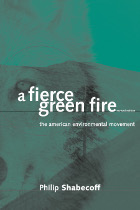
In A Fierce Green Fire, renowned environmental journalist Philip Shabecoff presents the definitive history of American environmentalism from the earliest days of the republic to the present. He offers a sweeping overview of the contemporary environmental movement and the political, economic, social and ethical forces that have shaped it. More importantly, he considers what today's environmental movement needs to do if it is to fight off the powerful forces that oppose it and succeed in its mission of protecting the American people, their habitat, and their future.
Shabecoff traces the ecological transformation of North America as a result of the mass migration of Europeans to the New World, showing how the environmental impulse slowly formed among a growing number of Americans until, by the last third of the 20th Century, environmentalism emerged as a major social and cultural movement. The efforts of key environmental figures -- among them Henry David Thoreau, George Perkins Marsh, Theodore Roosevelt, Gifford Pinchot, John Muir, Aldo Leopold, David Brower, Barry Commoner, and Rachel Carson -- are examined. So, too, are the activities of non-governmental environmental groups as well as government agencies such as the EPA and Interior Department, along with grassroots efforts of Americans in communities across the country. The author also describes the economic and ideological forces aligned against environmentalism and their increasing successes in recent decades.
Originally published in 1993, this new edition brings the story up to date with an analysis of how the administration of George W. Bush is seeking to dismantle a half-century of progress in protecting the land and its people, and a consideration of the growing international effort to protect Earth's life-support systems and the obstacles that the United States government is placing before that effort. In a forward-looking final chapter, Shabecoff casts a cold eye on just what the environmental movement must do to address the challenges it faces.
Now, at this time when environmental law, institutions, and values are under increased attack -- and opponents of environmentalism are enjoying overwhelming political and economic power -- A Fierce Green Fire is a vital reminder of how far we have come in protecting our environment and how much we have to lose.



Paul Shepard has been one of the most brilliant and original thinkers in the field of human evolution and ecology for more than forty years. His thought-provoking ideas on the role of animals in human thought, dreams, personal identity, and other psychological and religious contexts have been presented in a series of seminal writings, including Thinking Animals, The Tender Carnivore and the Sacred Game, and now The Others, his most eloquent book to date.
The Others is a fascinating and wide-ranging examination of how diverse cultures have thought about, reacted to, and interacted with animals. Shepard argues that humans evolved watching other animal species, participating in their world, suffering them as parasites, wearing their feathers and skins, and making tools of their bones and antlers. For millennia, we have communicated their significance by dancing, sculpting, performing, imaging, narrating, and thinking them. The human species cannot be fully itself without these others.
Shepard considers animals as others in a world where otherness of all kinds is in danger, and in which otherness is essential to the discovery of the true self. We must understand what to make of our encounters with animals, because as we prosper they vanish, and ultimately our prosperity may amount to nothing without them.
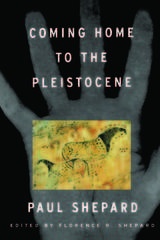
"When we grasp fully that the best expressions of our humanity were not invented by civilization but by cultures that preceded it, that the natural world is not only a set of constraints but of contexts within which we can more fully realize our dreams, we will be on the way to a long overdue reconciliation between opposites which are of our own making." --from Coming Home to the Pleistocene
Paul Shepard was one of the most profound and original thinkers of our time. Seminal works like The Tender Carnivore and the Sacred Game, Thinking Animals, and Nature and Madness introduced readers to new and provocative ideas about humanity and its relationship to the natural world. Throughout his long and distinguished career, Paul Shepard returned repeatedly to his guiding theme, the central tenet of his thought: that our essential human nature is a product of our genetic heritage, formed through thousands of years of evolution during the Pleistocene epoch, and that the current subversion of that Pleistocene heritage lies at the heart of today's ecological and social ills.
Coming Home to the Pleistocene provides the fullest explanation of that theme. Completed just before his death in the summer of 1996, it represents the culmination of Paul Shepard's life work and constitutes the clearest, most accessible expression of his ideas. Coming Home to the Pleistocene pulls together the threads of his vision, considers new research and thinking that expands his own ideas, and integrates material within a new matrix of scientific thought that both enriches his original insights and allows them to be considered in a broader context of current intellectual controversies. In addition, the book explicitly addresses the fundamental question raised by Paul Shepard's work: What can we do to recreate a life more in tune with our genetic roots? In this book, Paul Shepard presents concrete suggestions for fostering the kinds of ecological settings and cultural practices that are optimal for human health and well-being.
Coming Home to the Pleistocene is a valuable book for those familiar with the life and work of Paul Shepard, as well as for new readers seeking an accessible introduction to and overview of his thought.
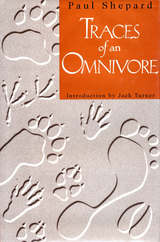
Paul Shepard is one of the most profound and original thinkers of our time. He has helped define the field of human ecology, and has played a vital role in the development of what have come to be known as environmental philosophy, ecophilosophy, and deep ecology -- new ways of thinking about human-environment interactions that ultimately hold great promise for healing the bonds between humans and the natural world. Traces of an Omnivore presents a readable and accessible introduction to this seminal thinker and writer.
Throughout his long and distinguished career, Paul Shepard has addressed the most fundamental question of life: Who are we? An oft-repeated theme of his writing is what he sees as the central fact of our existence: that our genetic heritage, formed by three million years of hunting and gathering remains essentially unchanged. Shepard argues that this, "our wild Pleistocene genome," influences everything from human neurology and ontogeny to our pathologies, social structure, myths, and cosmology.
While Shepard's writings travel widely across the intellectual landscape, exploring topics as diverse as aesthetics, the bear, hunting, perception, agriculture, human ontogeny, history, animal rights, domestication, post-modern deconstruction, tourism, vegetarianism, the iconography of animals, the Hudson River school of painters, human ecology, theoretical psychology, and metaphysics, the fundamental importance of our genetic makeup is the predominant theme of this collection.
As Jack Turner states in an eloquent and enlightening introduction, the essays gathered here "address controversy with an intellectual courage uncommon in an age that exults the relativist, the skeptic, and the cynic. Perused with care they will reward the reader with a deepened appreciation of what we so casually denigrate as primitive life -- the only life we have in the only world we will ever know."

The Poisoned Well offers vital strategies for citizens, community organizations, and public officials who want to fight the battle against pollutants.
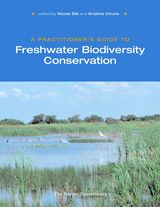
A Practitioner's Guide to Freshwater Biodiversity Conservation brings together knowledge and experience from conservation practitioners and experts around the world to help readers understand the global challenge of conserving biodiversity in freshwater ecosystems. More importantly, it offers specific strategies and suggestions for managers to use in establishing new conservation initiatives or improving the effectiveness of existing initiatives.
The book: offers an understanding of fundamental issues by explaining how ecosystems are structured and how they support biodiversity; provides specific information and approaches for identifying areas most in need of protection; examines promising strategies that can help reduce biodiversity loss; and describes design considerations and methods for measuring success within an adaptive management framework.
The book draws on experience and knowledge gained during a five-year project of The Nature Conservancy known as the Freshwater Initiative, which brought together a range of practitioners to create a learning laboratory for testing ideas, approaches, tools, strategies, and methods.
For professionals involved with land or water management-including state and federal agency staff, scientists and researchers working with conservation organizations, students and faculty involved with freshwater issues or biodiversity conservation, and policymakers concerned with environmental issues-the book represents an important new source of information, ideas, and approaches.

In Soft City David Sim, partner and creative director at Gehl, shows how this is possible, presenting ideas and graphic examples from around the globe. He draws from his vast design experience to make a case for a dense and diverse built environment at a human scale, which he presents through a series of observations of older and newer places, and a range of simple built phenomena, some traditional and some totally new inventions.
Sim shows that increasing density is not enough. The soft city must consider the organization and layout of the built environment for more fluid movement and comfort, a diversity of building types, and thoughtful design to ensure a sustainable urban environment and society.
Soft City begins with the big ideas of happiness and quality of life, and then shows how they are tied to the way we live. The heart of the book is highly visual and shows the building blocks for neighborhoods: building types and their organization and orientation; how we can get along as we get around a city; and living with the weather. As every citizen deals with the reality of a changing climate, Soft City explores how the built environment can adapt and respond.
Soft City offers inspiration, ideas, and guidance for anyone interested in city building. Sim shows how to make any city more efficient, more livable, and better connected to the environment.


It’s falling from the sky and in the air we breathe. It’s in our food, our clothes, and our homes. It’s microplastic and it’s everywhere—including our own bodies. Scientists are just beginning to discover how these tiny particles threaten health, but the studies are alarming.
In A Poison Like No Other, Matt Simon reveals a whole new dimension to the plastic crisis, one even more disturbing than plastic bottles washing up on shores and grocery bags dumped in landfills. Dealing with discarded plastic is bad enough, but when it starts to break down, the real trouble begins. The very thing that makes plastic so useful and ubiquitous – its toughness – means it never really goes away. It just gets smaller and smaller: eventually small enough to enter your lungs or be absorbed by crops or penetrate a fish’s muscle tissue before it becomes dinner.
Unlike other pollutants that are single elements or simple chemical compounds, microplastics represent a cocktail of toxicity: plastics contain at least 10,000 different chemicals. Those chemicals are linked to diseases from diabetes to hormone disruption to cancers.
A Poison Like No Other is the first book to fully explore this new dimension of the plastic crisis, following the intrepid scientists who travel to the ends of the earth and the bottom of the ocean to understand the consequences of our dependence on plastic. As Simon learns from these researchers, there is no easy fix. But we will never curb our plastic addiction until we begin to recognize the invisible particles all around us.
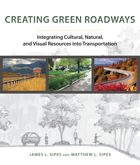
The authors examine traditional, utilitarian methods of transportation planning that have resulted in a host of negative impacts: from urban sprawl and congestion to loss of community identity and excess air and water pollution. They offer a better approach—one that blends form and function. Creating Green Roadways covers topics including transportation policy, the basics of green road design, including an examination of complete streets, public involvement, road ecology, and the economics of sustainable roads. Case studies from metropolitan, suburban, and rural transportation projects around the country, along with numerous photographs, illustrate what makes a project successful.
The need for this information has never been greater, as more than thirty percent of America’s major roads are in poor or mediocre condition, more than a quarter of the nation’s bridges are structurally deficient or functionally obsolete, and congestion in communities of all sizes has never been worse. Creating Green Roadways offers a practical strategy for rethinking how we design, plan, and maintain our transportation infrastructure.
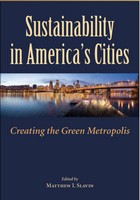
As sustainability rises to the top of public policy agendas in American cities, it is also emerging as a new discipline in colleges and universities. Specifically designed for these educational programs, this is the first book to provide empirically based, multi-disciplinary case studies of sustainability policy, planning, and practice in action. It is also valuable for everyone who designs and implements sustainability initiatives, including policy makers, public sector and non-profit practitioners, and consultants.
Sustainability in America's Cities brings together academic and practicing professionals to offer firsthand insight into innovative strategies that cities have adopted in renewable energy and energy efficiency, climate change, green building, clean-tech and green jobs, transportation and infrastructure, urban forestry and sustainable food production. Case studies examine sustainability initiatives in a wide range of American cities, including San Francisco, Honolulu, Philadelphia, Phoenix, Milwaukee, New York City, Portland, Oregon and Washington D.C. The concluding chapter ties together the empirical evidence and recounts lessons learned for sustainability planning and policy.
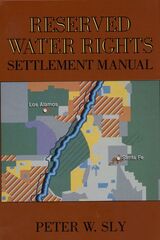

Traditionally protected as monopolies, electric utilities are now being caught in the fervor for deregulation that is sweeping the country. Nearly forty states have enacted or are considering laws and regulations that will profoundly alter the way the electric utility industry is governed. Concerned citizens are beginning to ponder the environmental implications of such a change, and while many fear that the pressure of competition will exacerbate environmental problems, others argue that deregulation provides a tremendous opportunity for citizens to work toward promoting cleaner energy and a more sustainable way of life.
In Reinventing Electric Utilities, Ed Smeloff and Peter Asmus consider the challenges for citizens and the utility industry in this new era of competition. Through an in-depth case study of the Sacramento Municipal Utility District (SMUD), a once-troubled utility that is now widely regarded as a model for energy efficiency and renewable energy development, they explore the changes that have occurred in the utility industry, and the implications of those changes for the future. The SMUD portrait is complemented by regional case studies of Portland General Electric and the Washington Public Power Supply System, the New England Electric Service, Northern States Power, the Electricity Reliability Council of Texas, and others that highlight the efforts of citizen groups and utilities to eliminate unproductive and environmentally damaging sources of power and to promote the use of new, cleaner energy technologies.
The authors present and explain some of the fundamental principles that govern restructuring, while acknowledging that solutions will depend upon the unique resource needs, culture, and utility structure of each particular region. Smeloff and Asmus argue that any politically sustainable restructuring of the electric services industry must address the industry's high capital cost commitments and environmental burdens.
Throughout, they make the case that with creative leadership, open and competitive markets, and the active participation of citizens, this upheaval offers a unique opportunity for electric utilities to lessen the burden of electricity production on the environment and reduce the cost of electric services through the use of more competitive, cleaner power sources.
While neither technological innovation nor the magic of the market will in and of itself reinvent the electric utility industry, the influence of those dynamic forces must be understood. Reinventing Electric Utilities is an important work for policymakers, energy professionals, and anyone concerned about the future of the electric services industry.
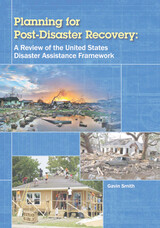
Although researchers pointed to this problem at least twenty-five years ago, an unfortunate reality remains: disaster recovery is the least understood aspect of emergency management among both scholars and practitioners. In addition, the body of knowledge that does exist has not been effectively disseminated to those who engage in disaster recovery activities.
Planning for Post-Disaster Recoveryblends what we know about disaster recovery from the research literature with an analysis of existing practice to uncover problems and recommend solutions. It is intended for hazard scholars, practitioners, and others who have not assimilated or acted upon the existing body of knowledge, or who are unexpectedly drawn into the recovery process following a disaster.
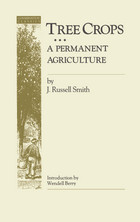
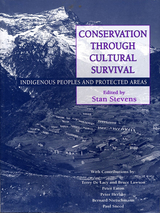
For more than a century the establishment of national parks and protected areas was a major threat to the survival of indigenous people. The creation of parks based on wilderness ideals outlawed traditional ways of life and forced from their homelands peoples who had shaped and preserved local ecosystems for centuries.
Today such tragic conflicts are being superseded by new alliances for conservation. Conservation Through Cultural Survival assesses cutting-edge efforts to establish new kinds of parks and protected areas which are based on partnerships with indigenous peoples. It chronicles new conservation thinking and the establishment around the world of indigenously inhabited protected areas, provides detailed case studies of the most important types of co-managed and indigenously managed areas, and offers guidelines, models, and recommendations for international action. The book:
- discusses the goals and development of the global protected area system
- assesses the strengths and limitations of a range of different types of indigenously inhabited protected areas
- discusses key issues and indigenous peoples' concerns
- recommends measures to promote conservation
- suggests international actions that would promote co-managed and indigenously managed areas
Conservation Through Cultural Survival will be required reading for environmentalists, protected area planners and managers, and all who care about the future of indigenous peoples and their homelands.
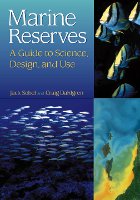
Conventional fishery management practices have failed to prevent the collapse of numerous fish stocks around the world. Amid growing concern about our ability to protect marine biodiversity and ecosystem integrity, scientists and managers alike are seeking alternative management tools. One of the most promising of those is no-take marine reserves -- areas of the sea where all consumptive use of natural resources is prohibited.
Marine Reserves is the first guidebook on no-take marine reserves, providing a synthesis of information on the underlying science, as well as design and implementation issues. The book, by Jack Sobel and Craig Dahlgren, describes the need for marine reserves and their potential benefits, examines how reserves can be designed to achieve specific objectives, and considers gaps in our knowledge and the research needed to address those gaps. Chapters examine: marine biological and geophysical issues relevant to reserve design; potential economic and biological benefits of marine reserves, and the likelihood of achieving them; influence of social and economic factors on reserve design and implementation; lessons learned from past efforts to establish marine reserves.
Also included are three case studies from California, Belize, and the Bahamas, as well as a review of experiences globally across a broad range of geographical locations, socioeconomic conditions, and marine environments. Case studies provide background on the history of marine reserves in each location, the process by which reserves were created, and the effect of the reserves on marine populations and communities as well as on human communities.
Marine Reserves represents an invaluable guide for fishery managers and marine protected area managers in creating and implementing effective marine reserves, and an accessible reference for environmentalists and others concerned with the conservation of marine resources. It will also be useful in undergraduate and graduate courses in marine ecology, fisheries, marine policy, and related fields.
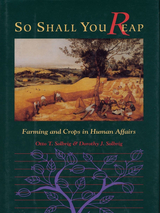
So Shall You Reap is a broad-gauged exploration of the intersections of farming and history. Beginning with the prehistorical era, Otto and Dorothy Solbrig describe the evolution of farming. When and how did people learn to irrigate, to fertilize, to rotate their crops -- and why?
Along with its fundamental importance to history, farming has radically altered the physical world. Natural landscapes have been completely transformed to provide room for growth on a large scale of a few species of plants and even fewer species of domesticated animals. Agriculture has altered the earth's biosphere and changed its geosphere: The soil has been modified, forests have been felled, swamps have been drained, rivers have been dammed and diverted.
So Shall You Reap presents a fresh and informed perspective on how farming and the crops we grow have changed us and our environment. By understanding the nature of the origins and evolution of agriculture, we will be better prepared to anticipate what the future may hold in store, and what must be done to increase food production while minimizing environmental problems.
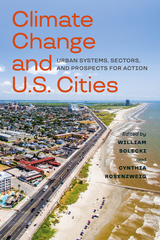
Prepared as a follow-up to the Fourth National Climate Assessment (NCA), Climate Change and U.S. Cities documents the current understanding of existing and future climate risk for U.S. cities, urban systems, and the residents that depend on them. Beginning with an examination of the existing science since 2012, chapters develop connections between existing and emerging climate risk, adaptation planning, and the role of networks and organizations in facilitating climate action in cities. From studies revealing disaster vulnerability among low-income populations to the development of key indicators for tracking climate change, this is an essential, foundational analysis. Importantly, the assessment puts a critical emphasis on the cross-cutting factors of economics, equity, and governance.
Urban stakeholders and decision makers will come away with a full picture of existing climate risks and a set of conclusions and recommendations for action. Many cities in the United States still have not yet planned for climate change and the costs of inaction are great. With bold analysis, Climate Change and U.S. Cities reveals the need for action and the tools that cities must harness to effect decisive, meaningful change.

In this provocative collection of essays, renowned architect Daniel Solomon delves into the complexities of what makes a city vibrant. Acknowledging that a city is not a static thing, he argues we need to pay more attention to nurturing what he calls “continuous cities.” In such a city, he says, “new buildings, new institutions, and new technologies don’t rip apart the old and wreck it. They accommodate, they act with respect, and they add vibrant new chapters to history without eradicating it.”
Continuity, he explains, is the way to promote sustainability— and contrary to what the advocates of “modern architecture” claim, he insists that honoring the traditional ways of city building still provides a solid foundation for places to grow, evolve, be modern.
However fond you are of your city, or however much you feel it needs improvement, this short collection of essays offers an enticing vision of the future. All of our cities have a past worth examining, a richness of experience that can shape the future in wonderful, surprising ways. Solomon’s prose is thought-provoking and inspiring, well worth keeping close by wherever you do your reading—be it your bedside, couch, a park, or on the metro.

"This is a book about the making of cities and the buildings that compose them. It is about the conditions under which an architect engaged in those activities now works, how those conditions evolved and why they are changing. It is about the qualities of life that are threatened by the ways cities are built at the beginning of the 21st century and intelligent response to those threats. It is about why the city planning ideas and the cultural cuisinart that came in the box with modern architecture are a lingering menace." -- from Global City Blues.
Much of the architecture and town planning of the past fifty years has been based on an unsubstantiated optimism about the promise of modernity. In our rush to embrace the future, we invented new ways of building that rejected the past and sent people headlong into a placeless limbo where they are insulated from each other and cut off from such basic experiences of location as the weather and the time of day. Despite calamitous results, many architects and planners remain enamored of the modernist ideals that underlie these changes.
In Global City Blues, renowned architect Daniel Solomon presents a perceptive overview and an insightful assessment of how the power and seductiveness of modernist ideals led us astray. Through a series of independent but linked essays, he takes the reader on a personal picaresque, introducing us to people, places, and ideas that have shaped thinking about planning and building and that laid the foundation for his beliefs about the world we live in and the kind of world we should be making.
As an alternative, Daniel Solomon discusses the ideas and precepts of New Urbanism, a reform movement he helped found that has risen to prominence in the past decade. New Urbanism offers a vital counterbalance to the forces of sprawl, urban disintegration, and placelessness that have so transformed the contemporary landscape.
Global City Blues is a fresh and original look at what the history of urban form can teach us about creating built environments that work for people.
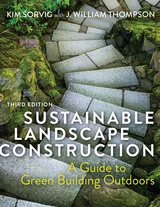
Like its predecessors, the new edition of Sustainable Landscape Construction is organized around principles, recognizing that built environments, and our work in them, pose both pragmatic and ethical challenges. Each chapter focuses on one overarching site goal, such as “Pave Less,” “Heal Injured Sites,” and “Consider Origin and Fate of Materials.” These principles of land sustainability are clearly articulated and developed through specific examples of more than 100 projects from around the world, reflecting both traditions and recent innovations. Expanded coverage of industry trends toward performance monitoring, and of lessons from project failures, form an important enhancement in this edition. New content also details the necessity to plan adaptively, not just preventively, for the realities of changing climate and intensifying weather. Some of the trends covered will shift how landscape architects and contractors will do business in challenging years ahead: to survive, many professionals and clients will focus on restoration projects, motivated by ecosystem services and social justice, and funded by innovative methods.
Sustainable Landscape Construction is part of the canon of landscape construction texts, and with this update, remains a visionary, one of a kind reference for professionals and students.
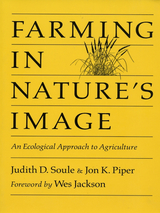
˜Farming in Nature's Image provides, for the first time, a detailed look into the pioneering work of The Land Institute, the leading educational and research organization for sustainable agriculture.
The authors draw on case studies, hands-on experience, and research results to explain the applications of a new system of agriculture based on one unifying concept: that farms should mimic the ecosystems in which they exist. They present both theoretical and practical information, including:
- a review of the environmental degradation resulting from current farming practices
- a critical evaluation of the attempts to solve these problems
- a detailed description of the ecosystem perspective and the proposed new agricultural system
- a case study illustrating how this new system could be applied to temperate grain production using perennial seed crops and the prairie as a model
- an examination of the potential savings in energy and water use, as well as potential contributions to ecological experiments and yield analysis work from The Land Institute.
Written in clear, non-technical language, this book will be of great interest to soil and agricultural scientists, academics, policymakers, environmentalists, and other concerned with finding long-range solutions to agricultural problems.
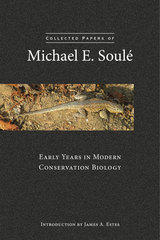
This book is a select collection of seminal writings by Michael Soulé over a thirty-year time-span from 1980 through the present day. Previously published in books and leading journals, these carefully selected pieces show the progression of his intellectual thinking on topics such as genetics, ecology, evolutionary biology, and extinctions, and how the history and substance of the field of conservation biology evolved over time. It opens with an in-depth introduction by marine conservation biologist James Estes, a long-time colleague of Soulé’s, who explains why Soulé’s special combination of science and leadership was the catalyst for bringing about the modern era of conservation biology. Estes offers a thoughtful commentary on the challenges that lie ahead for the young discipline in the face of climate change, increasing species extinctions, and impassioned debate within the conservation community itself over the best path forward.
Intended for a new generation of students, this book offers a fresh presentation of goals of conservation biology, and inspiration and guidance for the global biodiversity crises facing us today. Readers will come away with an understanding of the science, passion, idealism, and sense of urgency that drove early founders of conservation biology like Michael Soulé.
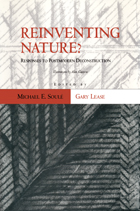
How much of science is culturally constructed? How much depends on language and metaphor? How do our ideas about nature connect with reality? Can nature be "reinvented" through theme parks and malls, or through restoration?
Reinventing Nature? is an interdisciplinary investigation of how perceptions and conceptions of nature affect both the individual experience and society's management of nature. Leading thinkers from a variety of fields -- philosophy, psychology, sociology, public policy, forestry, and others -- address the conflict between perception and reality of nature, each from a different perspective. The editors of the volume provide an insightful introductory chapter that places the book in the context of contemporary debates and a concluding chapter that brings together themes and draws conclusions from the dialogue.
In addition to the editors, contributors include Albert Borgmann, David Graber, N. Katherine Hayles, Stephen R. Kellert, Gary P. Nabhan, Paul Shepard, and Donald Worster.


The Wildlands Project is a far-reaching effort by scientists and activists to develop better ways of protecting nature, wilderness, and biodiversity. Its ultimate goal is to establish an effective network of nature reserves throughout North America -- core conservation areas linked by corridors, and buffered, where appropriate, by lands that may also serve economic objectives.
Continental Conservation represents the work of thirty leading experts-including Michael Soulé, John Terborgh, Reed Noss, Paul Paquet, Dan Simberloff, Rodolfo Dirzo, J. Michael Scott, Andrew Dobson, and others -- brought together by The Wildlands Project to examine the science underlying the design and management of these regional-scale networks. It provides conservationists and biologists with the latest scientific principles for protecting living nature at spatial scales that encompass entire regions and continents.
Following an opening chapter that sets the stage by introducing major themes and the scientific and policy background, the contributors:
- consider scale in the identification, selection, and design of biological reserves
- examine the role of top carnivores in regulating terrestrial ecosystems
- suggest the need for a paradigm shift in the field of ecological restoration
- consider the scientific details of implementing regional conservation in core areas, corridors, and in buffer zones
- discuss the need for megareserves and how to design them
The book ends by challenging the reader, whether scientist or advocate, to commit more time to the effort of saving nature. The authors argue that the very survival of nature is at stake, and scientists can no longer afford to stand behind a wall of austere objectivity.
Continental Conservation is an important guidebook that can serve a vital role in helping fashion a radically honest, scientifically rigorous land-use agenda. It will be required reading for scientists and professionals at all levels involved with ecosystem and land management.

The topic of streets and street design is of compelling interest today as public officials, developers, and community activists seek to reshape urban patterns to achieve more sustainable forms of growth and development. Streets and the Shaping of Towns and Cities traces ideas about street design and layout back to the early industrial era in London suburbs and then on through their institutionalization in housing and transportation planning in the United States. It critiques the situation we are in and suggests some ways out that are less rigidly controlled, more flexible, and responsive to local conditions.
Originally published in 1997, this edition includes a new introduction that addresses topics of current interest including revised standards from the Institute of Transportation Engineers; changes in city plans and development standards following New Urbanist, Smart Growth, and sustainability principles; traffic calming; and ecologically oriented street design.

—David Owen, staff writer at the New Yorker
Nearly every US city would like to be more walkable—for reasons of health, wealth, and the environment—yet few are taking the proper steps to get there. The goals are often clear, but the path is seldom easy. Jeff Speck’s follow-up to his bestselling Walkable City is the resource that cities and citizens need to usher in an era of renewed street life. Walkable City Rules is a doer’s guide to making change in cities, and making it now.
The 101 rules are practical yet engaging—worded for arguments at the planning commission, illustrated for clarity, and packed with specifications as well as data. For ease of use, the rules are grouped into 19 chapters that cover everything from selling walkability, to getting the parking right, escaping automobilism, making comfortable spaces and interesting places, and doing it now!
Walkable City was written to inspire; Walkable City Rules was written to enable. It is the most comprehensive tool available for bringing the latest and most effective city-planning practices to bear in your community. The content and presentation make it a force multiplier for place-makers and change-makers everywhere.

The dream scenario could bring huge public and private benefits, including more transportation choices, greater affordability and accessibility, and healthier, more livable cities, along with reduced greenhouse gas emissions. The nightmare scenario could bring more urban sprawl, energy use, greenhouse gas emissions, and unhealthy cities and individuals.
In Three Revolutions, transportation expert Dan Sperling, along with seven other leaders in the field, share research–based insights on potential public benefits and impacts of the three transportation revolutions. They describe innovative ideas and partnerships, and explore the role government policy can play in steering the new transportation paradigm toward the public interest—toward our dream scenario of social equity, environmental sustainability, and urban livability.
Many factors will influence these revolutions—including the willingness of travelers to share rides and eschew car ownership; continuing reductions in battery, fuel cell, and automation costs; and the adaptiveness of companies. But one of the most important factors is policy.
Three Revolutions offers policy recommendations and provides insight and knowledge that could lead to wiser choices by all. With this book, Sperling and his collaborators hope to steer these revolutions toward the public interest and a better quality of life for everyone.
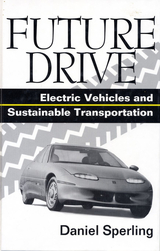
In Future Drive, Daniel Sperling addresses the adverse energy and environmental consequences of increased travel, and analyzes current initiatives to suggest strategies for creating a more environmentally benign system of transportation. Groundbreaking proposals are constructed around the idea of electric propulsion as the key to a sustainable transportation and energy system. Other essential elements include the ideas that:
- improving technology holds more promise than large-scale behavior modification
- technology initiatives must be matched with regulatory and policy initiatives
- government intervention should be flexible and incentive-based, but should also embrace selective technology-forcing measures
- more diversity and experimentation is needed with regard to vehicles and energy technologies
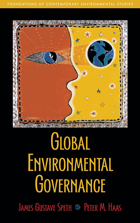
Global Environmental Governance offers the essential information, theory, and practical insight needed to tackle this critical challenge. It examines ten major environmental threats-climate disruption, biodiversity loss, acid rain, ozone depletion, deforestation, desertification, freshwater degradation and shortages, marine fisheries decline, toxic pollutants, and excess nitrogen-and explores how they can be addressed through treaties, governance regimes, and new forms of international cooperation.
Written by Gus Speth, one of the architects of the international environmental movement, and accomplished political scientist Peter M. Haas, Global Environmental Governance tells the story of how the community of nations, nongovernmental organizations, scientists, and multinational corporations have in recent decades created an unprecedented set of laws and institutions intended to help solve large-scale environmental problems. The book critically examines the serious shortcomings of current efforts and the underlying reasons why disturbing trends persist. It presents key concepts in international law and regime formation in simple, accessible language, and describes the current institutional landscape as well as lessons learned and new directions needed in international governance. Global Environmental Governance is a concise guide, with lists of key terms, study questions, and other features designed to help readers think about and understand the concepts discussed.
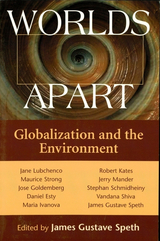
Worlds Apart presents a cohesive set of essays by leading thinkers on the subject of globalization, offering a thoughtful overview of the major environmental issues related to globalization in a clear, reasoned style. Framed by Gus Speth’s introduction and conclusion, essays range from Jane Lubchenco’s discussion of the scientific indicators of global environmental change to Robert Kates’ examination of the prospect that our growing global interconnectedness could lead a transition to a more sustainable world to Vandana Shiva’s impassioned plea for a new “living democracy” that counters the degrading, dehumanizing tendencies of the global economy. Other contributors include Maurice Strong on the Rio Earth Summit and the future course of environmentalism, José Goldemberg on energy, Jerry Mander on the inherent destructiveness of the global economic system, Stephan Schmidheiny on the forestry industry, and Daniel Esty and Maria Ivanova on global environmental governance.
Edited by one of the world’s leading experts on international environmental issues, the book brings together the most respected thinkers and actors on the world stage to offer a compelling set of perspectives and a solid introduction to the social and environmental dimensions of globalization.
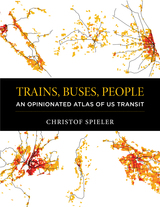
In the US, the 25 largest metropolitan areas and many smaller cities have fixed guideway transit—rail or bus rapid transit. Nearly all of them are talking about expanding. Yet discussions about transit are still remarkably unsophisticated. To build good transit, the discussion needs to focus on what matters—quality of service (not the technology that delivers it), all kinds of transit riders, the role of buildings, streets and sidewalks, and, above all, getting transit in the right places.
Christof Spieler has spent over a decade advocating for transit as a writer, community leader, urban planner, transit board member, and enthusiast. He strongly believes that just about anyone—regardless of training or experience—can identify what makes good transit with the right information. In the fun and accessible Trains, Buses, People: An Opinionated Atlas of US Transit, Spieler shows how cities can build successful transit. He profiles the 47 metropolitan areas in the US that have rail transit or BRT, using data, photos, and maps for easy comparison. The best and worst systems are ranked and Spieler offers analysis of how geography, politics, and history complicate transit planning. He shows how the unique circumstances of every city have resulted in very different transit systems.
Using appealing visuals, Trains, Buses, People is intended for non-experts—it will help any citizen, professional, or policymaker with a vested interest evaluate a transit proposal and understand what makes transit effective. While the book is built on data, it has a strong point of view. Spieler takes an honest look at what makes good and bad transit and is not afraid to look at what went wrong. He explains broad concepts, but recognizes all of the technical, geographical, and political difficulties of building transit in the real world. In the end,Trains, Buses, People shows that it is possible with the right tools to build good transit.
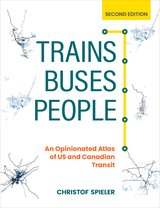
-Planning
In some US and Canadian cities, transit has quietly been expanding and improving over the last few years, despite funding and ridership challenges. How do we assess the advances and failures of our current systems to move forward strategically and wisely?
The first edition of Trains, Buses, People was dubbed “a transit wonk’s bible” and guided “a smarter conversation about urban transit” in the US. This second edition is fully updated and expanded to include eight Canadian cities and two new US cities (Indianapolis and San Juan, Puerto Rico).
In Trains, Buses, People, Second Edition: An Opinionated Atlas of US and Canadian Transit, transit expert and “transportation hero” Christof Spieler provides a new section on inclusivity to help agencies understand how to welcome riders regardless of race, gender, income, or disability. Select cities include new maps overlaying transit and poverty data, and systems that have started construction since the first edition in 2018 have been added. Other new sections address network typologies, guideway types, station types, and fares.
Spieler has spent over a decade advocating for transit as a writer, community leader, urban planner, transit board member, and enthusiast. He strongly believes that just about anyone—regardless of training or experience—can identify what makes good transit with the right information. In the fun, accessible, and visually appealing Trains, Buses, People, Second Edition: An Opinionated Atlas of US and Canadian Transit, Spieler shows how cities can build successful transit. He profiles the 49 metropolitan areas in the US and eight metropolitan areas in Canada that have rail transit or BRT, using data, photos, and maps for easy comparison. Spieler ranks the best and worst systems and he offers analysis of how geography, politics, and history complicate transit planning. He shows how the unique circumstances of every city have resulted in very different transit systems.
Trains, Buses, People, Second Edition is intended for non-experts—it will help any citizen, professional, or policymaker with a vested interest evaluate a transit proposal and understand what makes transit effective. It shows that it is possible, with the right tools, to build good transit.
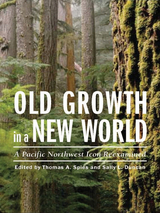
Old Growth in a New World untangles the complexities of the old growth concept and the parallel complexity of old-growth policy and management. It brings together more than two dozen contributors—ecologists, economists, sociologists, managers, historians, silviculturists, environmentalists, timber producers, and philosophers—to offer a broad suite of perspectives on changes that have occurred in the valuing and management of old-growth forests in the Pacific Northwest over the past thirty years. The book
• introduces the issues and history of old-growth values and conservation in the Pacific Northwest;
• explores old growth through the ideas of leading ecologists and social scientists;
• addresses the implications for the future management of old-growth forests and considers how evolving science and social knowledge might be used to increase conservation effectiveness.
By confronting the complexity of the old-growth concept and associated policy and management challenges, Old Growth in a New World encourages productive discussion on the future of old growth in the Pacific Northwest and offers options for more effective approaches to conserving forest biodiversity.

In the US, the design choices made by the typical architecture firm employee each year can reduce emissions by about 300 times that of an average American. But the promise of sustainable architecture will not be realized if sustainability remains a secondary consideration for architects. What if great design were defined by its ability to cool the planet, heal communities, enhance ecological functioning, and advance justice?
In People, Planet, Design, architect Corey Squire builds the case, provides the data, and lays out the practical tools for a transformative human-centered architecture. This approach integrates beauty and delight with an awareness of how every design choice impacts the community, the planet, and the people who will use the building. Outcome-focused with a deep dive into practical design strategies, the book showcases ten building systems that embody design excellence.
Squire centers the idea that by focusing on the desired outcomes—that buildings shelter us from the elements without disconnecting us from the world, that buildings provide the quality of air, light, and views we now know to be essential to health, productivity, and joy—we can move beyond the checklist mentality that has captured much of the design community.
Essential reading for architects who want to transform what the profession means, People, Planet, Design pioneers a new vision and sets readers up with clear guidance on implementing it. Only when design prioritizes people, as it should, can architecture realize its full potential.

In The Power of Existing Buildings, academic sustainability expert Robert Sroufe, and construction and building experts Craig Stevenson and Beth Eckenrode, explain how to realize the potential of existing buildings and make them perform like new. This step-by-step guide will help readers to: understand where to start a project; develop financial models and realize costs savings; assemble an expert team; and align goals with numerous sustainability programs. The Power of Existing Buildings will challenge you to rethink spaces where people work and play, while determining how existing buildings can save the world.
The insights and practical experience of Sroufe, Stevenson, and Eckenrode, along with the project case study examples, provide new insights on investing in existing buildings for building owners, engineers, occupants, architects, and real estate and construction professionals. The Power of Existing Buildings helps decision-makers move beyond incremental changes to holistic, results-oriented solutions.
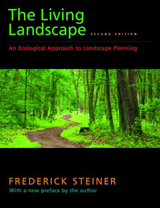
The Living Landscape offers
• a systematic, highly practical approach to landscape planning that maximizes ecological objectives, community service, and citizen participation
• more than 20 challenging case studies that demonstrate how problems were met and overcome, from rural America to large cities
• scores of checklists and step-by-step guides
• hands-on help with practical zoning, land use, and regulatory issues
• coverage of major advances in GIS technology and global sustainability standards
• more than 150 illustrations.
As Steiner emphasizes throughout this book, all of us have a responsibility to the Earth and to our fellow residents on this planet to plan with vision. We are merely visiting this planet, he notes; we should leave good impressions.

Human ecology is an emerging discipline that studies the interrelationships between humans and their environment, drawing on insights from biology, sociology, anthropology, geography, engineering, architecture, landscape architecture, planning, and conservation. A vast, multidisciplinary literature underscores this approach, and in Human Ecology, noted landscape planner Frederick Steiner synthesizes the work of diverse, sometimes divergent, scholars to illustrate how human interactions can be understood as ecological relationships, using hierarchy as an organizing device.
Steiner builds on the work of leading thinkers including Christopher Alexander, William Cronon, Clifford Geertz, James Lovelock, Eugene Odum, Paul Shepard, Anne Whiston Spirn, E. O. Wilson, Gerald Young, and many others to present a historical and analytical examination of how humans interact with each other as well as with other organisms and their surroundings.
The first two chapters summarize the development of this "new ecology" and the theory of human ecology. The remainder of the book provides an accessible introduction to the major elements of human ecological theory including language, culture, and technology; structure, function, and change; edges and boundaries; interaction, integration, and institution; diversity; and adaptation. The chapters are organized hierarchically from the smallest scale to the largest with each chapter addressing a specific level as an ecosystem. The final chapter probes some of the ethical implications of this new field.
Human Ecology brings together for the first time scholarship from the social and natural sciences as well as the environmental design arts to offer an overview of the field of human ecology and to show how the field may help us to envision our futures. While the approach is largely theoretical, it has broad policy and practical implications, and represents an important new work for anyone concerned with interactions between humans and the environment.
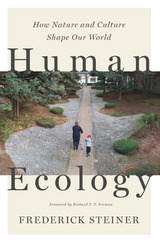
Human ecology is the study of the interrelationships between humans and their environment, drawing on diverse fields from biology and geography to sociology, engineering, and architecture. Steiner admirably synthesizes these perspectives through the lens of landscape architecture, a discipline that requires its practitioners to consciously connect humans and their environments. After laying out eight principles for understanding human ecology, the book’s chapters build from the smallest scale of connection—our homes—and expand to community scales, regions, nations, and, ultimately, examine global relationships between people and nature.
In this age of climate change, a new approach to planning and design is required to envision a livable future. Human Ecology provides architects, landscape architects, urban designers, and planners—and students in those fields— with timeless principles for new, creative thinking about how their work can shape a vibrant, resilient future for ourselves and our planet.
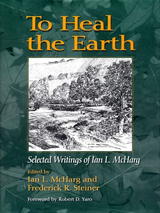
Ian L. McHarg's landmark book Design with Nature changed the face of landscape architecture and planning by promoting the idea that the design of human settlements should be based on ecological principles. McHarg was one of the earliest and most influential proponents of the notion that an understanding of the processes that form landscapes should underlie design decisions.
In To Heal the Earth, McHarg has joined with Frederick Steiner, a noted scholar of landscape architecture and planning, to bring forth a valuable cache of his writings produced between the 1950s and the 1990s. McHarg and Steiner have each provided original material that links the writings together, and places them within the historical context of planning design work and within the larger field of ecological planning as practiced today.
The book moves from the theoretical-beginning with the 1962 essay "Man and Environment" which sets forth the themes of religion, science, and creativity that emerge and reappear throughout McHarg's work--to the practical, including discussions of methods and techniques for ecological planning as well as case studies. Other sections address the link between ecology and design, and the issue of ecological planning at a regional scale, covering topics such as education and training necessary to develop the field of ecological planning, how to organize and arrange biophysical information to reveal landscape patterns, the importance of incorporating social factors into ecological planning, and more.
To Heal the Earth provides a larger framework and a new perspective on McHarg's work that brings to light the growth and development of his key ideas over a forty year period. It is an important contribution to the literature, and will be essential reading for students and scholars of ecological planning, as well as for professional planners and landscape architects.

The books are an outgrowth of a collaborative effort involving international nongovernmental organizations including the United Nations Food and Agriculture Organization (UN FAO), the International Livestock Research Institute (ILRI), the Swiss College of Agriculture (SHL), the French Agricultural Research Centre for International Development (CIRAD), and the Scientific Committee for Problems of the Environment (SCOPE).
Volume 1 examines the forces shaping change in livestock production and management; the resulting impacts on landscapes, land use, and social systems; and potential policy and management responses.
Volume 2 explores needs and draws experience from region-specific contexts and detailed case studies. The case studies describe how drivers and consequences of change play out in specific geographical areas, and how public and private responses are shaped and implemented.
Together, the volumes present new, sustainable approaches to the challenges created by fundamental shifts in livestock management and production, and represent an essential resource for policy makers, industry managers, and academics involved with this issue.
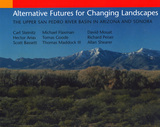
Leading landscape architect and planner Carl Steinitz has developed an innovative GIS-based simulation modeling strategy that considers the demographic, economic, physical, and environmental processes of an area and projects the consequences to that area of various land-use planning and management decisions. The results of such projections, and the approach itself, are known as "alternative futures."
Alternative Futures for Changing Landscapes presents for the first time in book form a detailed case study of one alternative futures project—an analysis of development and conservation options for the Upper San Pedro River Basin in Arizona and Sonora, Mexico. The area is internationally recognized for its high levels of biodiversity, and like many regions, it is facing increased pressures from nearby population centers, agriculture, and mining interests. Local officials and others planning for the future of the region are seeking to balance the needs of the natural environment with those of local human communities.
The book describes how the research team, working with local stakeholders, developed a set of scenarios which encompassed public opinion on the major issues facing the area. They then simulated an array of possible patterns of land uses and assessed the resultant impacts on biodiversity and related environmental factors including vegetation, hydrology, and visual preference. The book gives a comprehensive overview of how the study was conducted, along with descriptions and analysis of the alternative futures that resulted. It includes more than 30 charts and graphs and more than 150 color figures.
Scenario-based studies of alternative futures offer communities a powerful tool for making better-informed decisions today, which can help lead to an improved future. Alternative Futures for Changing Landscapes presents an important look at this promising approach and how it works for planners, landscape architects, local officials, and anyone involved with making land use decisions on local and regional scales.
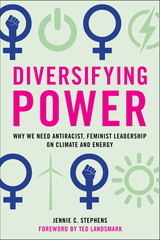
During the Trump era, connections among white supremacy; environmental destruction; and fossil fuel dependence have become more conspicuous. Many of the same leadership deficiencies that shaped the inadequate response in the United States to the coronavirus pandemic have also thwarted the US response to the climate crisis. The inadequate and ineffective framing of climate change as a narrow, isolated, discrete problem to be “solved” by technical solutions is failing. The dominance of technocratic, white, male perspectives on climate and energy has inhibited investments in social change and social innovations. With new leadership and diverse voices, we can strengthen climate resilience, reduce racial and economic inequities, and promote social justice.
In Diversifying Power, energy expert Jennie Stephens argues that the key to effectively addressing the climate crisis is diversifying leadership so that antiracist, feminist priorities are central. All politics is now climate politics, so all policies, from housing to health, now have to integrate climate resilience and renewable energy.
Stephens takes a closer look at climate and energy leadership related to job creation and economic justice, health and nutrition, housing and transportation. She looks at why we need to resist by investing in bold diverse leadership to curb the “the polluter elite.” We need to reclaim and restructure climate and energy systems so policies are explicitly linked to social, economic, and racial justice.
Inspirational stories of diverse leaders who integrate antiracist, feminist values to build momentum for structural transformative change are woven throughout the book, along with Stephens’ experience as a woman working on climate and energy. The shift from a divided, unequal, extractive, and oppressive society to a just, sustainable, regenerative, and healthy future has already begun.
But structural change needs more bold and ambitious leaders at all levels, like Alexandria Ocasio-Cortez with the Green New Deal, or the Secwepemc women of the Tiny House Warriors resisting the Trans Mountain pipeline.
Diversifying Power offers hope and optimism. Stephens shows how the biggest challenges facing society are linked and anyone can get involved to leverage the power of collective action. By highlighting the creative individuals and organizations making change happen, she provides inspiration and encourages transformative action on climate and energy justice.
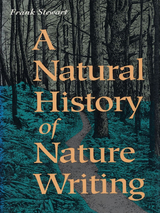
A Natural History of Nature Writing is a penetrating overview of the origins and development of a uniquely American literature. Essayist and poet Frank Stewart describes in rich and compelling prose the lives and works of the most prominent American nature writers of the19th and 20th centuries, including:
- Henry D. Thoreau, the father of American nature writing.
- John Burroughs, a schoolteacher and failed businessman who found his calling as a writer and elevated the nature essay to a loved and respected literary form.
- John Muir, founder of Sierra Club, who celebrated the wilderness of the Far West as few before him had.
- Aldo Leopold, a Forest Service employee and scholar who extended our moral responsibility to include all animals and plants.
- Rachel Carson, a scientist who raised the consciousness of the nation by revealing the catastrophic effects of human intervention on the Earth's living systems.
- Edward Abbey, an outspoken activist who charted the boundaries of ecological responsibility and pushed these boundaries to political extremes.
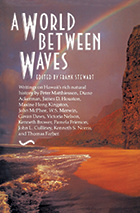
A World Between Waves is a collection of essays on the natural history of Hawaii by some of America's most renowned writers. It is a testament to the biological and geological wealth of this unique and threatened island landscape, and a passionate call to action on behalf of what may soon be gone.

Rodney grew up during the crack epidemic, with guns, drugs, and the threat of incarceration an accepted part of daily life for nearly everyone he knew. To rent his own apartment, he needed a paycheck—something the money from dealing drugs didn’t provide. For that, he took a position in 1992 with a new nonprofit, the Earth Conservation Corps. Gradually, Rodney fell in love with the work to restore and conserve the polluted Anacostia River that flows through D.C. As conditions along the river improved, he helped to reintroduce bald eagles to the region and befriended an injured Eurasian Eagle Owl named Mr. Hoots, the first of many birds whose respect he would work hard to earn.
Bird Brother is a story about pursuing dreams against all odds, and the importance of second chances. Rodney’s life was nearly upended when he was arrested on drug charges in 2002. The jail sentence sharpened his resolve to get out of the hustling life. With the fierceness of the raptors he had admired for so long, he began to train to become a master falconer and to develop his own raptor education program and sanctuary. Rodney’s son Mike, a D.C. firefighter, has also begun his journey to being a master falconer, with his own kids cheering him along the way.
Eye-opening, witty, and moving, Bird Brother is a love letter to the raptors and humans who transformed what Rodney thought his life could be. It is an unflinching look at the uphill battle Black children face in pursuing stable, fulfilling lives, a testament to the healing power of nature, and a reminder that no matter how much heartbreak we’ve endured, we still have the capacity to give back to our communities and follow our wildest dreams.
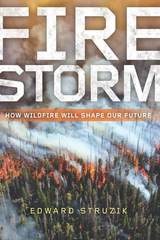
"Comprehensive and compelling." —Booklist
"A powerful message." —Kirkus
"Should be required reading." —Library Journal
For two months in the spring of 2016, the world watched as wildfire ravaged the Canadian town of Fort McMurray. Firefighters named the fire “the Beast.” It acted like a mythical animal, alive with destructive energy, and they hoped never to see anything like it again. Yet it’s not a stretch to imagine we will all soon live in a world in which fires like the Beast are commonplace. A glance at international headlines shows a remarkable increase in higher temperatures, stronger winds, and drier lands– a trifecta for igniting wildfires like we’ve rarely seen before.
This change is particularly noticeable in the northern forests of the United States and Canada. These forests require fire to maintain healthy ecosystems, but as the human population grows, and as changes in climate, animal and insect species, and disease cause further destabilization, wildfires have turned into a potentially uncontrollable threat to human lives and livelihoods.
Our understanding of the role fire plays in healthy forests has come a long way in the past century. Despite this, we are not prepared to deal with an escalation of fire during periods of intense drought and shorter winters, earlier springs, potentially more lightning strikes and hotter summers. There is too much fuel on the ground, too many people and assets to protect, and no plan in place to deal with these challenges.
In Firestorm, journalist Edward Struzik visits scorched earth from Alaska to Maine, and introduces the scientists, firefighters, and resource managers making the case for a radically different approach to managing wildfire in the 21st century. Wildfires can no longer be treated as avoidable events because the risk and dangers are becoming too great and costly. Struzik weaves a heart-pumping narrative of science, economics, politics, and human determination and points to the ways that we, and the wilder inhabitants of the forests around our cities and towns, might yet flourish in an age of growing megafires.
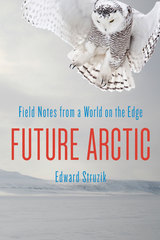
Future Arctic reveals the inside story of how politics and climate change are altering the polar world in a way that will have profound effects on economics, culture, and the environment as we know it. Struzik takes readers up mountains and cliffs, and along for the ride on snowmobiles and helicopters, sailboats and icebreakers. His travel companions, from wildlife scientists to military strategists to indigenous peoples, share diverse insights into the science, culture and geopolitical tensions of this captivating place. With their help, Struzik begins piecing together an environmental puzzle: How might the land’s most iconic species—caribou, polar bears, narwhal—survive? Where will migrating birds flock to? How will ocean currents shift? What fundamental changes will oil and gas exploration have on economies and ecosystems? How will vast unclaimed regions of the Arctic be divided?
A unique combination of extensive on-the-ground research, compelling storytelling, and policy analysis, Future Arctic offers a new look at the changes occurring in this remote, mysterious region and their far-reaching effects.

In Swamplands, journalist Edward Struzik celebrates these wild places, venturing into windswept bogs in Kauai and the last remnants of an ancient peatland in the Mojave Desert. The secrets of the swamp aren’t for the faint of heart. Ed loses a shoe to an Arctic wolf and finds himself ankle-deep in water during a lightning storm. But the rewards are sweeter for the struggle: an enchanting Calypso orchid; an elusive yellow moth thought to be extinct; ancient animals preserved in lifelike condition down to the fur.
Swamplands highlights the unappreciated struggle being waged to save peatlands by scientists, conservationists, and landowners around the world. An ode to peaty landscapes in all their offbeat glory, the book is also a demand for awareness of the myriad threats they face. It urges us to see the beauty and importance in these least likely of places. Our planet’s survival might depend on it.
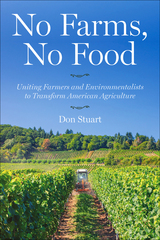
No Farms, No Food traces the development of this powerful coalition responsible for landmark achievements in farmland preservation and conservation practices. It all began with Peggy Rockefeller’s determination to stop the inexorable urban sprawl that was threatening the nation’s agriculture. From this humble start grew a small but astute organization, and more importantly, a formidable constituency of farmers and environmentalists united around a common cause.
With leadership from AFT, that constituency drove through Congress the first “Conservation Title” in the history of the U.S. Farm Bill; oversaw the development of agriculture conservation easement programs throughout the country; and continues to develop innovative approaches to sustainable agriculture.
No Farms, No Food takes readers inside the political and policy battles that determine the fate of our nation’s farmland. And it illustrates the tactics needed to unify fractured interest groups for the common good. No Farms, No Food is both an inspiring history of agricultural conservation and a practical guide to creating an effective advocacy organization. This is an essential read for everyone who cares about the future of our food, farms, and environment.
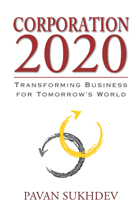
We aren’t stuck with this dysfunctional corporate model, but business needs a new DNA if it is to enact the comprehensive approach we need. Pavan Sukhdev lays out a sweeping new vision for tomorrow’s corporation: one that will increase human wellbeing and social equity, decrease environmental risks and ecological losses, and still generate profit. Through a combination of internal changes in corporate governance and external regulations and policies, Corporation 2020 can become a reality in the next decade—and it must, argues Sukhdev, if we are to avert catastrophic social imbalance and ecological harm.
Corporation 2020 presents new approaches to measuring the true costs of business and the corporation’s obligation to society. From his insightful look into the history of the corporation to his thoughtful discussion of the steps needed to craft a better corporate model, Sukhdev offers a hopeful vision for the role of business in shaping a more equitable, sustainable future.
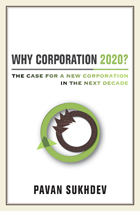
Available free at major online booksellers.
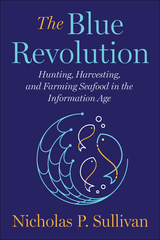
Nicholas P. Sullivan presents this new way of thinking about fish, food, and oceans by profiling the people and policies transforming an aging industry into one that is “post-industrial”—fueled by “sea-foodies” and locavores interested in sustainable, traceable, quality seafood. Catch quotas can work when local fishers feel they have a stake in the outcome; shellfish farming requires zero inputs and restores nearshore ecosystems; new markets are developing for kelp products, as well as unloved and “underutilized” fish species. Sullivan shows how the practices of thirty years ago that perpetuated an overfishing crisis are rapidly changing. In the book’s final chapters, Sullivan discusses the global challenges to preserving healthy oceans, including conservation mechanisms, the impact of climate change, and unregulated and criminal fishing in international waters.
In a fast-growing world where more people are eating more fish than ever before, The Blue Revolution brings encouraging news for conservationists and seafood lovers about the transformation of an industry historically averse to change, and it presents fresh inspiration for entrepreneurs and investors eager for new opportunities in a blue-green economy.

Environmental policy studies commissioned by government agencies or other stakeholders can play a vital role in environmental decisionmaking; they provide much-needed insight into policy options and specific recommendations for action. But the results of even the most rigorous studies are frequently misappropriated or misunderstood and are as likely to confuse an issue as they are to clarify it.
Better Environmental Policy Studies explores this problem, as it considers the shortcomings of current approaches to policy studies and presents a pragmatic new approach to the subject. Reviewing five cases that are widely regarded as the most effective policy studies to have been conducted in the United States in the last few decades, the authors present a comprehensive guide to the concepts and methods required for conducting effective policy studies. The book:
- describes and explains the conventional approach to policy studies and its shortcoming
- presents the history, impacts, and common elements of five successful policy studies
- offers an in-depth look at the different tools and techniques of policy analysis
- extends the concepts and principles of successful policy studies to their potential uses in the international arena
Better Environmental Policy Studies presents a practical, battle-tested approach to overcoming the obstacles to formulating effective environmental policy. It is an invaluable resource for students and faculty in departments of environmental studies, public policy and administration, and planning, as well as for professional policy analysts and others involved with making decisions and mediating disputes over environmental issues.

When business leaders, government officials, and other stakeholders come to the table in an environmental, health, or safety dispute, acrimony often results, leading to expensive and time-consuming litigation. Not only does this waste precious resources, but rarely does the process produce the best outcome for any of the parties involved.
For the past five years, the authors of this volume have conducted semi-annual seminars at the Massachussetts Institute of Technology and at Harvard to provide business leaders and regulators with the knowledge and skills they need to more effectively handle environmental, health, and safety negotiations. Their strategy, known as the "mutual gains approach," is a proven method of producing fairer, more efficient, more stable, and wiser results. Negotiating Environmental Agreements provides the first comprehensive introduction to this widely practiced and highly effective approach to environmental regulation.
The book begins with an overview of the mutual gains approach, introducing important concepts and ideas from negotiation theory as well as the theory and practice of mediation. The authors then offer five model negotiations from their MIT-Harvard Public Disputes seminar, followed by a series of real-world negotiated environmental agreements that illustrate the kinds of outcomes possible when the mutual gains approach is employed. A collection of writings by leading experts provide valuable insights into the process, and appendixes offer both instructions for conducting model negotiation sessions and analysis of actual game results from earlier seminars.
This is the only prescriptive text available for the many regulatees and regulators involved in environmental regulatory negotiations each year. Anyone involved with environmental negotiation -- including corporate and public sector managers, students of environmental policy, environmental management, and business management -- will find the book an essential resource.
READERS
Browse our collection.
PUBLISHERS
See BiblioVault's publisher services.
STUDENT SERVICES
Files for college accessibility offices.
UChicago Accessibility Resources
home | accessibility | search | about | contact us
BiblioVault ® 2001 - 2024
The University of Chicago Press









